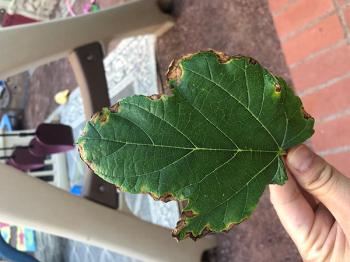August 24, 2019
Salt Burn on Leaf Edges: Causes and Solutions
Question:
Can you tell what seems to be plaguing the various rosebushes in my backyard?
– L. Peters, Sandoval County, NM
Answer:
Thanks for sending such great photos with your rosebush question. These photos depict rose foliage with varying degrees of browning edges on the leaflets and some white crusty buildup on leaflet surfaces, especially at the margins. Some of the leaflets have a burned look with black edges.
First off, the leaf margin damage looked to me like salt burn, and I asked Dr. Curtis Smith, retired NMSU horticulture specialist, to weigh in. Dr. Smith agreed that the tissue necrosis at the leaflet tips and margins might be due to salt burn. Salt accumulation at these points is caused when dissolved salts are brought up to the leaves from the roots during transpiration. This could be due to salts in the soil or in the irrigation water that accumulate over time. As water transpires from tiny pores in the leaves, the dissolved salts are left behind. The salts left at the leaf margin kill plant cells in those spots when they build to toxic levels, causing that burned appearance, as well as the crusty white buildup, especially on the older leaves.
I recently received photos of similarly damaged mulberry leaves from Albuquerque. In the past year, the NMSU Plant Diagnostic Clinic has processed leaf samples diagnosed with salt damage from Bernalillo, Doña Ana, Eddy, Otero, and Valencia Counties from all kinds of landscape plants, including boxwood, juniper, ponderosa pine, euonymus, crape myrtle, sycamore, and several fruit trees. I’m trying to demonstrate that salt problems are prevalent in our soils and, therefore, our plants too.

In the chapter on roses in the 1967 edition of her book, Southwest Gardening, Rosalie Doolittle recommends watering deeply at five- to seven-day intervals during the hottest months and then less frequently in the winter. She warns, “More failures in rose growing in this area result from overwatering than any other cause… Light and frequent irrigation causes feeder roots to grow close to the surface and they are easily injured from heat and wind.” By “watering deeply,” she means 1–2 feet for many shrubs, less for plants with smaller roots, and more for larger root systems, like trees, which still maintain the vast majority of their water-absorbing root tissues in the top three feet of the soil profile.
The salt burn symptoms on roses may be alleviated by irrigating once or twice with a larger volume of water to help push the salts down through the soil profile and away from the roots. This technique can also be used once in the winter after leaves have dropped when more water is expected to percolate down into the soil since the plant isn’t actively taking as much water up from the root zone. Salt buildup often occurs in the top few inches of the soil profile with repeated shallow waterings. I’m also concerned that we are increasing the chances of salt toxicity in our soils by over fertilizing. Many fertilizers come in the form of salts and may either exacerbate or even cause salt burn on leaves.

Both Dr. Smith and Ms. Doolittle recommend mulching to conserve moisture and help keep soil temperatures moderate. But no matter what you do, the portions of the leaf that have browned will never green back up, so you’ll have to be patient and wait for new green leaves to emerge.
Powdery mildew, which is very common on roses and other landscape plants, especially during monsoon season in New Mexico, may also be present on the leaf surfaces in some of the photos. Powdery mildew is caused by a fungus that’s always present, but around here it doesn’t usually show up noticeably until late summer. It also doesn’t usually cause much of a problem, other than being mildly unsightly. My general recommendation for powdery mildew on ornamental plants is to first double check that you’re not accidentally sprinkling water on the leaves when you irrigate, and then, instead of applying an antifungal spray, just sit back and blame it on the rain. For more powdery mildew identification and treatment tips, visit the Desert Blooms blog version of this column where I’ve included photos and links.
Marisa Y. Thompson, PhD, is the Extension Horticulture Specialist, in the Department of Extension Plant Sciences at the New Mexico State University Los Lunas Agricultural Science Center, email: desertblooms@nmsu.edu, office: 505-865-7340, ext. 113.
Links:
For more gardening information, visit the NMSU Extension Horticulture page at Desert Blooms and the NMSU Horticulture Publications page.
Send gardening questions to Southwest Yard and Garden - Attn: Dr. Marisa Thompson at desertblooms@nmsu.edu, or at the Desert Blooms Facebook page.
Please copy your County Extension Agent and indicate your county of residence when you submit your question!